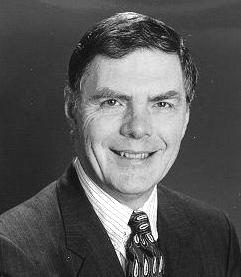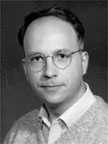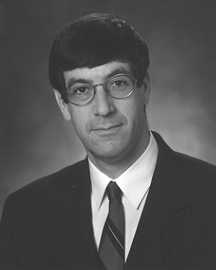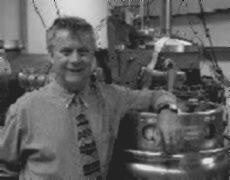
Chairís Message February, 1999
1998 was another banner year for laser science and for our Division. DLS members whose work in laser science has been recognized by major APS awards include Steve Lamoreaux (Pipkin Award) Terry Miller (Broida Prize), Dave Pratt (Plyler Prize), Mark Raizen (Rabi Prize), and Carl Wieman (Schawlow Prize). In addition, 15 DLS members have been chosen as new Fellows of the APS (see the accompanying article). We warmly congratulate all those who have been honored, acknowledging how important their contributions to laser science have been and how these honors touch everyone in the DLS.
At the end of last October's Interdisciplinary Laser Science Conference (the annual meeting of our Division), I took over the position of DLS Chair from Paul Houston who now assumes the role of Past Chair. Bob Boyd became Chair-Elect and, and Marsha Lester joins the succession as the newly elected Vice Chair. Also joining the DLS governance are newly elected Executive Committee members Randy Hulet and Linda Young. We welcome these new members of the DLS Executive Committee and thank all the people whose continuing service to DLS has been so important.
The Division of Laser Science has a unique status and unique opportunities to serve the laser science community within the APS. We represent a diversity of disciplines as symbolized in both our name (where "Science" rather than "Physics" appears) and our annual meeting. Our executive committee also reflects this diversity and we strive to serve all of our membership. I hope that all of the DLS membership will help us to maintain this disciplinary diversity by suggesting appropriate names for new executive committee members to the nominating committee (e.g., to Phil Gould <gould@uconnvm.uconn.edu> or Harold Metcalf<harold.metcalf@sunysb.edu>), and by initiating nominations for APS fellowship through the DLS.
Because we are the Division within APS that benefits from the income generated by the CLEO/QELS meeting held under the auspices of the Joint Council on Quantum Electronics, we often have resources allowing us to pursue programs that benefit laser science. Among these are: The Distinguished Traveling Lectureship program, which honors individual laser scientists and brings their insights and enthusiasm to students in educational institutions which might not otherwise benefit from such visits; Student travel grants, providing support for students presenting papers at meetings with DLS involvement.; and Summer Undergraduate Research Grants, allowing students the opportunity to participate in laser science research, including research away from their home institution. We are pleased that travel grants will be supporting 17 students at the March Centennial meeting of the APS in Atlanta.
If you are interested in taking advantage of any of these DLS programs, please visit our home page at http://www.physics.wm.edu/~cooke/dls/dls.html, also accessible via http://www.aps.org (and we thank Bill Cooke for maintaining the DLS page). Sometimes the indicated deadlines may be flexible, so check with the DLS Secretary-Treasurer Win Smith <winthrop@uconnvm.uconn.edu> if you have any questions. Remember that the deadline for Fellowship nominations is coming up April 1, and that Marsha Lester <milester@sas.upenn.edu> chairs the Fellowship committee. Finally, if you have some ideas on how we might better serve the laser science community, please pass them on to one of the members of the Executive Committee. Just as our community relies on your creativity in scientific research, we want to tap your creativity in this area as well.
William D. Phillips
Keep up on the Division of Laser Science on the DLS home page at http://www.physics.wm.edu/~cooke/dls/dls.html
or via the APS home page (click on Division) at:
http://www.aps.org
1999 APS AWARD WINNERS
DLS members were the recipients of several major APS awards and prizes for their research in laser science. See http://www.aps.org/praw/praw95.html for more information on these honors.

Citation: For his far-ranging contributions to spectroscopy and chemical physics of diatomics and radicals, his development of methods for plasma diagnostics, and for his stewardship of the Ohio State Spectroscopy Conference.
Background: Dr. Millerís research centers around the spectroscopic identification, characterization and monitoring of reactive chemical intermediates. He has developed a number of experimental spectroscopic techniques spanning frequencies from the microwave to the ultraviolet. Systems studied have ranged from simple atoms to aromatic radicals and ions. At present, his laboratory is applying a battery of spectroscopic techniques including LIF, REMPI, ZEKE, CRD, and fluorescence depletion spectroscopy to the characterization of the structure and dynamics of a number of interesting chemical intermediates, including the alkoxy radicals, organometallic reactive intermediates, and aromatic organic radicals.

Citation: For extensive contributions to precision measurements science, especially searches for permanent electric dipole moment of the neutron and atoms, measurements of atomic parity violation, and tests of spatial symmetries and quantum mechanics, including observation of the vacuum Casimir Effect.
Background: Dr. Lamoreaux has many areas of interest including precision atomic and neutron experimental techniques; the theory of neutron matter interactions; lasers and optoelectronics, and radiofrequency spectroscopy. His current work includes classical and quantum cryptography, quantum computing, and tests of fundamental interactions using ultracold neutrons. He is the co-author of two books, "Ultracold Neutrons", and "CP Violations without Strangeness: The Electric Dipole Moments of Particles, Atoms and Molecules."

Citation: For his pioneering advances in the experimental study of atom optics, and especially for the insightful connections he has developed between this discipline and studies of chaotic dynamics, condensed matter physics, and dissipative quantum systems.
Background: During the past seven years, Dr. Raizen and his group have been working in the field of atom optics. The main focus of their research has been to study how quantum mechanics suppresses classical chaos, by a mechanism known as dynamical localization. Recent work in his group has studied the effects of dissipation in going from quantum to classical behavior.

Citation: For pioneering work in ultrahigh resolution ultraviolet spectroscopy of cold molecules in beams that elucidated the structure and isomerization dynamics of a wide range of large molecules, molecular vibrational dynamics, and hydrogen bonding.
Background: Dr. Pratt's research in high resolution electronic spectroscopy uses lasers, molecular beams, and high speed data acquisition systems to study the structures and dynamical behaviors of a wide range of isolated large molecules and their clusters at unparalleled spectral resolution, ~ 1MHz in the UV. Using this approach, he and his students have demonstrated that even very large molecules have well-defined eigenstates at energies of 3-4 eV, and that studies of these states provide unique information about molecular size and shape, about intermolecular interactions, and about the dynamical behavior of molecules following the absorption of light. Currently, his research group is focusing on chemical reaction dynamics, and on the eigenstates that participate in the light-induced transformations of reactants into products.

Citation: For pioneering work on the production and study of Bose-Einstein condensation in a dilute atomic vapor, which has become a major testing ground for macroscopic quantum phenomena, and quantum statistical mechanics.
Background: Dr Wieman has carried out research in laser spectroscopy, with an emphasis on laser cooling and trapping of atoms and the measurement of parity nonconservation (PNC). Recently his group made the most precise measurement of atomic PNC; in the process, they made the first measurement of an anapole moment. He also is studying the properties of Bose-Einstein condensates in a variety of systems. He is involved in developing new ways to teach physics to non-scientists.
INTERDISCIPLINARY LASER SCIENCE
CONFERENCE
ILS-XV
The 15th Annual Interdisciplinary Laser Science Meeting (ILS-XV) will be held in Santa Clara, CA on September 26 - October 1, 1999. The 1999 Meeting, which is run jointly with the OSA Annual Meeting, will bring together an exciting multidisciplinary group of scientists to discuss new work in the rapidly moving fields of laser science and applications.
The focus of the ILS meeting is emerging areas that will form the future critical technologies of the new millennium. The Plenary talk, Critical Review Tutorials, and Symposia highlight some of the most exciting and important advances in our understanding of lasers and laser-matter interactions. Professor H. Jeff Kimble from Caltech is the Plenary Speaker, and will present a talk on "The Quantum Optics Circus - Flying Photons, Acrobatic Atoms, and Teleported Tuataras". Four Critical Review talks will feature topics as diverse as advanced single molecule and nonlinear surface probes, EUV lithography, and sonoluminescence.
DLS has agreed to cover the registration fees for student members who attend the conference. The deadline for paper submission is April 7, for submission by mail, and April 9 for electronic submission. Further information about ILS '99 can be obtained at http://www.osa.org/mtg_conf/.
Lewis Rothberg, University of Rochester, Conference Chair
Margaret Murnane, University of Michigan, Program Chair
1998 APS FELLOWS
Congratulations to the DLS members who were named as APS Fellows in 1998! Members nominated by the DLS are indicated by an asterisk after their names.
Jeffrey Bokor*, University of California, Berkeley
For contributions to laser science, including short-wavelength lasers and non-linear optics, development of time-resolved, two-photon photoemission, and contributions to extreme ultraviolet lithography and sub-micron MOSFET device development
Lee Wendel Casperson*, Portland State University
For his pioneering contributions to the field of laser instabilities, the discovery of the laser instability that bears his name, and his numerous advances in laser and resonator design
Peter Mark Felker, UCLA
For the development of rotational coherence spectroscopy and ion-detected Raman spectroscopy and major contributions in the study of molecular clusters and intermolecular interactions
Gerald Timothy Fraser, NIST
For major contributions to the understanding of weak intermolecular forces, vibrational couplings, intramolecular vibrational energy redistribution, and the development of the technique of electric-resonance optothermal spectroscopy
Arunava, Gupta, IBM T.J. Watson Research Center
For contributions to the development of pulsed laser deposition techniques, the use of this technique for the production of materials with novel physical properties, and for original contributions to the understanding of nonequilibrium film-growth mechanisms
Rajendra Gupta*, University of Arkansas
For the first Doppler-free spectroscopy of optically inaccessible states of alkali atoms, for the most complete study of photothermal technique in flowing fluids, and for innovative use of photothermal technique to combustion diagnostics
Mark Douglas Havey, Old Dominion University
For development and explication of novel one- and two-photon spectroscopies of bound and dissociative electronic states of diatomic molecules; also for development of precision atomic two-photon polarization spectroscopy for determination of atomic matrix elements and novel sum rule
Siu Au Lee, Colorado State University
For contributions to the field of high resolution laser spectroscopy, and for precision experiments in hydrogen and in tests of special relativity
Arthur Eugene Livingston, University of Notre Dame
For his contributions to the understanding of relatvistic, QED, and Rydberg state atomic structures through the spectroscopy of highly-charged ions, and for precise determinations of excited-state lifetimes involving allowed and forbidden atomic transitions
Jabez Jenkins McClelland, NIST
For elucidation of spin polarized electron-atom interactions, and for pioneering development and application of atom optical methods in nanostructure fabrication
Thomas Ralph Rizzo, Ecole Polytechnique Federale de Lausanne
For development and application of double resonance and infrared photodissociation techniques to studying unimolecular reactions and vibrational spectroscopy
Kazimierz Rzazewski*, Polish Academy of Sciences
For creative application of the methods of quantum optics to frontier problems of strong-field and atomic physics
Arnold J. Schmidt*, Technical University of Vienna
For his contributions to ultrafast optics and leadership role in the funding of scientific research in Austria
Herbert Walther*, Max-Planck-Institut für Quantenoptik
In recognition of his fundamental contributions to the quantum optics of atoms
Krzysztof Wodkiewicz*, Warsaw University
For key contributions to our understanding of the role of stochastic processes in nonlinear optical resonance, and for path-breaking studies of the operational approach to quantum phase-space measurements
NOMINATIONS SOUGHT FOR 1999 APS FELLOWS
The DLS has made many distinguished contributions to the list of APS Fellows, including the nomination of seven elected this year. Nominations for next year's fellowships are now being solicited.
The number of DLS nominations chosen to be forwarded to the APS for confirmation as Fellow in a given year is typically in the range 5-10. This depends on the good judgement of the nominators and the Divisional Committee on Fellows headed by the DLS Vice-Chair, Marsha Lester, but the Committee can do nothing without nominations. This is where DLS members must come into the picture. The Executive Committee is urging all DLS members to consider whether they know of a colleague who is deserving of the prized honor of APS Fellowship. If you are uncertain about a colleague's status, consult the APS Membership Directory, where an asterisk identifies Fellows. Nominations for deserving women, minority, and foreign DLS members are especially sought.
Any member can nominate any other member, and the supporting documentation is not difficult to assemble. The deadline for a nomination and supporting letters to reach the APS, in time for DLS consideration, is April 1, 1999. All of the required information is available on the WWW at http://www.aps.org/fellowship/fellinfo.html Further information can be obtained from the APS at (301) 209-3268 (phone), (301) 209-0865 (fax), or email at fellowship@aps.org.
DISTINGUISHED TRAVELING LECTURER PROGRAM
IN LASER SCIENCE
The Distinguished Traveling Lecturer (DTL) program provides funds to send outstanding scientists and communicators in the areas covered by DLS to visit predominantly undergraduate colleges and universities. Visits are for two days and generally include lectures and informal meetings with students and faculty. Details about the program and the application procedure can be found at the DLS web site at http://www.physics.wm.edu/~cooke/dls/p_dtl.html. Applications for Fall 1999 are due March 15, 1999.
The DTLs for the 1999-2000 Academic Year are:
STUDENT TRAVEL GRANTS
The DLS is pleased to continue its program to support student travel to DLS-sponsored meetings. A limited number of grants for travel and living expenses, up to $700, are available to graduate students who are DLS members and who are authors or co-authors on an oral or poster paper at the ILS-XIV meeting. To make these funds as widely available as possible, some priority will be given to requests for a lower level of support and to distribution of these grants to students of different institutions. Complete details concerning the application process can be found on the DLS Web Site. The applicants will be evaluated by the selection committee chaired by Dr. Winthrop W. Smith.
Applications should be sent to Professor Winthrop W. Smith, DLS Secretary-Treasurer, at the Department of Physics, University of Connecticut, 2152 Hillside Road,Storrs, CT 06268-3046. Fax: 860-486-3346, email: <winthrop@uconnvm.uconn.edu>. The deadline for submitting applications for the QELS/CLEO Meeting is March 20, 1999. The deadline for the ILS-XV/OSA Meeting is August 10, 1999.
UNDERGRADUATE RESEARCH IN
LASER SCIENCE
The Undergraduate Research in Laser Science Program provides support for students to conduct laser-related research in the summer between the their junior and senior year. For example, two recent research projects have now led to refereed publications acknowledging DLS support. One by Chris Carlen of the Department of Chemistry at Moravian College, Bethleham, PA (faculty advisor David J. McGee) was published in Optics Communications v. 152, 342 (1998) under the title "Influence of chromophore solubility on optical absorption and two-beam coupling gain in guest-host photorefractive polymer composites". A second DLS-sponsored project was by Adam H. Marshall of Trinity University, San Antonio, TX and was under the supervision of faculty advisor Daniel R. Spiegel. This paper, with co-authors N.T. Jukam (Trinity U.), H.S. Park and T. Chang (Pohang University of Science and Technology, Korea) was published in the Journal of Chemical Physics v. 109, 267 (1998) on the topic "Measurement of mass diffusion coefficients using nonexponential forced Rayleigh scattering signals". Spiegel reports that Adam Marshall is now an NSF Fellow in graduate school at the University of Chicago. DLS summer funding was much appreciated in both of these cases.
The DLS invites proposals for the summer of 1999. The research may be performed at the student's home institution, or at any other U.S. undergraduate or graduate institution at which the student's faculty sponsor can provide close supervision. Full details of the application guidelines can be found on the DLS web site at http://www.physics.wm.edu/~cooke/dls/p_sres.html. Proposals should be submitted in writing by March 6, 1998 to Professor Winthrop Smith, Department of Physics, University of Connecticut, 2152 Hillside Road, Storrs, CT 06269-3046. E-mail inquires to <winthrop@uconnvm.uconn.edu>.
Maria Goeppert-Mayer Distinguished Scholar
Argonne National Laboratory has established the position of Maria Goeppert-Mayer Distinguished Scholar to attract leading women scientists and engineers to the Laboratory. This position has been established to recognize outstanding achievement by a woman scientist or engineer and to provide opportunities for her to conduct innovative research utilizing the special environment and capabilities offered by Argonne. Candidates should be scientists or engineers of proven talent and accomplishment, at points of very high promise or distinction in their careers. Creativity, plus recognized accomplishment in a field of current or potential interest to Argonne, will be two prime factors in judging candidates. The award is for a period of one year, typically starting in October. Applications are due February 28 for appointments starting the following October. Information is available at http://www.anl.gov/CMB/mgm.html. For additional information, interested parties should contact Maryka Bhattacharyya, <bhatt@anlcmb.bim.anl.gov>.
Nominations Sought for the
ARTHUR L. SCHAWLOW PRIZE IN LASER SCIENCE
Purpose: To recognize outstanding contributions to basic research which uses lasers to advance our knowledge of the fundamental physical properties of materials and their interaction with light. Some examples of relevant areas of research are: nonlinear optics, ultrafast phenomena, laser spectroscopy, squeezed states, quantum optics, multiphoton physics, laser cooling and trapping, physics of lasers, particle acceleration by lasers, and short wavelength lasers.
Nomination Deadline: The deadline for submission of nominations for the 2000 Prize is: JULY 1, 1999. Guidelines can be found at: http://www.aps.org/praw/nomguide.html. Nominations should be sent to the Chair of the 2000 Prize Selection Committee:
Robert W Field
Dept of Chem 6-219 Phone (617) 253-1489
MIT Fax (617) 253-7030
77 Massachusetts Ave Email rwfield@mit.edu
Cambridge MA 02139
& CALENDAR
APS Centennial
http://www.aps.org/centennial
CLEO '99, May 23-28, 1999, Baltimore, MD. The Quantum Electronics and Laser Science (QELS) Conference is co-located with CLEO '99.
http://www.osa.org/Mtg-conf
14th International Conference on Laser Spectroscopy, June 7-11, 1999, Innsbruck, Austria.
http://physics.uibk.ac.at/ICOLS99
Ultrafast Optics '99, Zurich, July 11-16, 1999.
International Conference on the Physics of Electronic and Atomic Collisions, July 22-27, 1999, Sendai, Japan
http://power1.pc.uec.ac.ap/Sendai
Gordon Conference on Nonlinear Optics and Lasers, July 25-30, 1999, New London, NH.
http://www.grc.uri.edu/programs
Gordon Conference on Quantum Control of Atoms and Molecules,
Plymouth, NH, August 1-6, 1999.
ILS-XV, co-located with OSA '99 Annual meeting, September 26 - October 1. 1999, Santa Clara, CA.
http://www.osa.org/Mtg-conf and http://www.aps-org - Divisions Ė DLS
8th International Conference on Multiphoton Processes (ICOMP), October 3-11, 1999, Monterey, CA.
http://www.engr.ucdavis.edu/~icomp8/icomp.html
|
DLS EXECUTIVE COMMITTEE |
Chair
Chair-Elect
Robert W. Boyd, University of Rochester
Vice Chair
Marsha I. Lester, University of Pennsylvania
Secretary-Treasurer
Winthrop W. Smith, University of Connecticut
Past-Chair
Paul L. Houston, Cornell University
Divisional APS Councilor
Daniel R. Grischkowsky, Oklahoma State University
Members at Large
Randall Hulet, Rice University
John C. Miller, Oak Ridge National Laboratory
Thomas W. Mossberg, University of Oregon
Margaret M. Murnane, University of Michigan
Doreen A. Weinberger, Smith College
Linda Young, Argonne National Laboratory
APS Representatives to Joint Council on Quantum Electronics
Ian A. Walmsley, University of Rochester
Richard R. Freeman, Lawrence Livermore National Laboratory
Newsletter Editor
Jeanne M. Hossenlopp, Marquette University
|
ILS PROGRAM |
|
COMMITTEE |
Lewis J. Rothberg, University of Rochester, Conference Chair
Lasers in Chemistry Subcommittee
Lasers in Ultrafast Nonlinear Phenomena Subcommittee
Lasers in Physics Subcommittee
Physics of Laser Sources Subcommittee
Margaret Murnane, University of Michigan, Program Chair
Phillipe Guyot-Sinnet, University of Chicago, Chair
Arjun G. Yodh, University of Pennsylvania
Lee Richter, NIST
David M. Jonas, University of Colorado at Boulder
David Chandler, Sandia National Laboratory
Michael Barnes, Oak Ridge National Laboratory
Ian Walmsley, University of Rochester, Chair
Nora Berrah, Western Michigan University
Hailin Wang, University of Oregon
David D. Meyerhofer, University of Rochester
Mike Raymer, Oregon Center for Optics and University of Oregon
Almantas Galvanauskas, IMRA
Robert Jones, University of Virginia, Chair
H. Jeff Kimble, California Institute of Technology
S.E. Harris, Stanford University
Naomi Halas, Rice University
Jabez McClelland, NIST
Gustav Gerber, University of Wuerzburg
Gary Eden, University of Illinois, Chair
Peter Yu, University of California at Berkeley
Howard Powell, Lawrence Livermore National Laboratory
Jorge Rocca, Colorado State University
Louis DiMauro, Brookhaven National Laboratory
Dennis Deppe, University of Texas, Austin
Doug Bamford, Gemfire Corporation